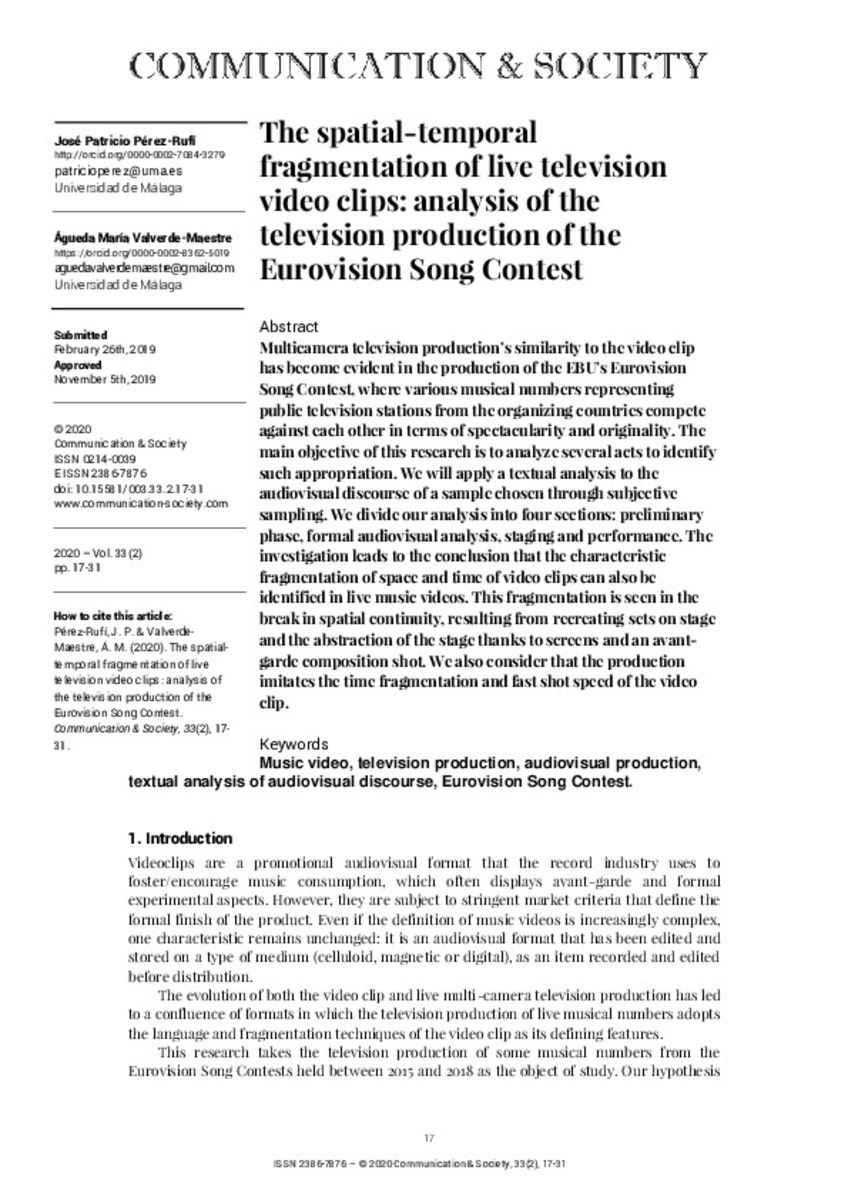Full metadata record
| DC Field | Value | Language |
|---|---|---|
| dc.creator | Pérez-Rufí, J.P. (José Patricio) | - |
| dc.creator | Valverde-Maestre, A.M. (Águeda María) | - |
| dc.date.accessioned | 2020-04-20 | - |
| dc.date.accessioned | 2021-11-09T08:27:26Z | - |
| dc.date.available | 2021-11-09T08:27:26Z | - |
| dc.date.issued | 2020 | - |
| dc.identifier.citation | Pérez-Rufí, J.P. (José Patricio); Valverde-Maestre, A.M. (Águeda María). "The spatial-temporal fragmentation of live television video clips: analysis of the television production of the Eurovision Song Contest". Communication & Society. 33 (2), 2020, 17 - 31 | es |
| dc.identifier.issn | 2386-7876 | - |
| dc.identifier.uri | https://hdl.handle.net/10171/62357 | - |
| dc.description.abstract | Multicamera television production’s similarity to the video clip has become evident in the production of the EBU’s Eurovision Song Contest, where various musical numbers representing public television stations from the organizing countries compete against each other in terms of spectacularity and originality. The main objective of this research is to analyze several acts to identify such appropriation. We will apply a textual analysis to the audiovisual discourse of a sample chosen through subjective sampling. We divide our analysis into four sections: preliminary phase, formal audiovisual analysis, staging and performance. The investigation leads to the conclusion that the characteristic fragmentation of space and time of video clips can also be identified in live music videos. This fragmentation is seen in the break in spatial continuity, resulting from recreating sets on stage and the abstraction of the stage thanks to screens and an avant-garde composition shot. We also consider that the production imitates the time fragmentation and fast shot speed of the video clip. | en_US |
| dc.description.abstract | Multicamera television production’s similarity to the video clip has become evident in the production of the EBU’s Eurovision Song Contest, where various musical numbers representing public television stations from the organizing countries compete against each other in terms of spectacularity and originality. The main objective of this research is to analyze several acts to identify such appropriation. We will apply a textual analysis to the audiovisual discourse of a sample chosen through subjective sampling. We divide our analysis into four sections: preliminary phase, formal audiovisual analysis, staging and performance. The investigation leads to the conclusion that the characteristic fragmentation of space and time of video clips can also be identified in live music videos. This fragmentation is seen in the break in spatial continuity, resulting from recreating sets on stage and the abstraction of the stage thanks to screens and an avant-garde composition shot. We also consider that the production imitates the time fragmentation and fast shot speed of the video clip. | es_ES |
| dc.language.iso | spa | - |
| dc.publisher | Servicio de Publicaciones de la Universidad de Navarra | es_ES |
| dc.rights | info:eu-repo/semantics/openAccess | es_ES |
| dc.subject | Music video | - |
| dc.subject | television production | - |
| dc.subject | audiovisual production | - |
| dc.subject | textual analysis of audiovisual discourse | - |
| dc.subject | Eurovision Song Contest | - |
| dc.title | The spatial-temporal fragmentation of live television video clips: analysis of the television production of the Eurovision Song Contest | es_ES |
| dc.title.alternative | The spatial-temporal fragmentation of live television video clips: analysis of the television production of the Eurovision Song Contest | en_US |
| dc.type | info:eu-repo/semantics/article | es_ES |
| dc.identifier.doi | 10.15581/003.33.2.17-31 | - |
| dadun.citation.endingPage | 31 | - |
| dadun.citation.number | 2 | - |
| dadun.citation.publicationName | Communication & Society | - |
| dadun.citation.startingPage | 17 | - |
| dadun.citation.volume | 33 | - |
Files in This Item:
Statistics and impact
Items in Dadun are protected by copyright, with all rights reserved, unless otherwise indicated.






